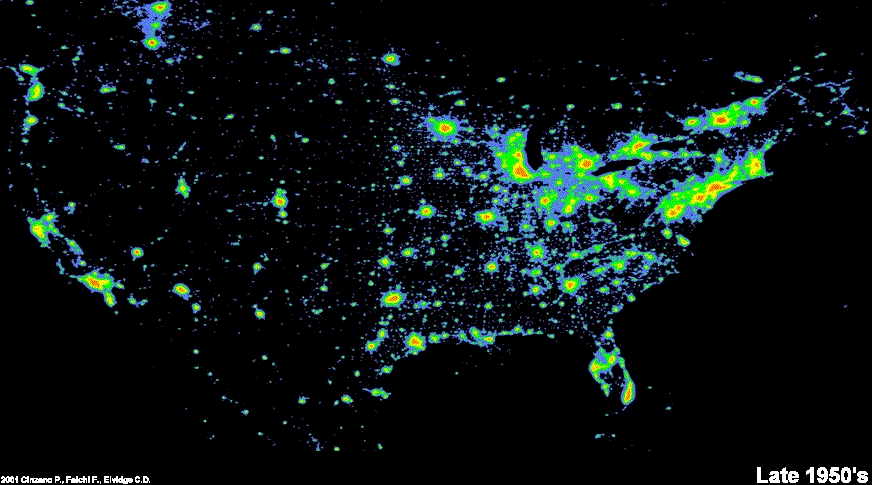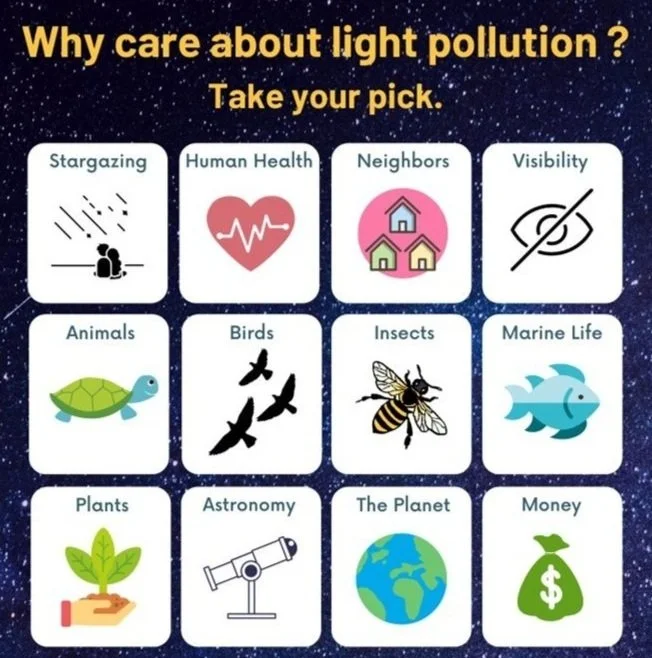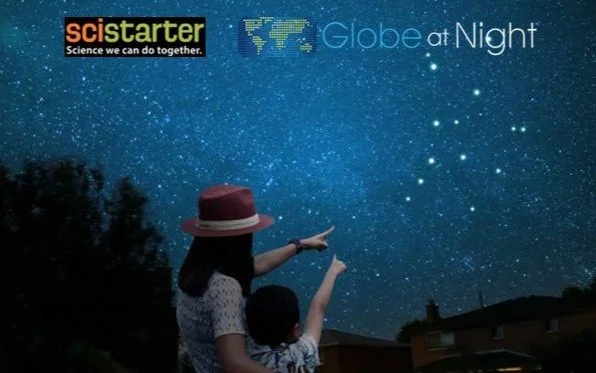
What is light pollution?
Light pollution is the excessive, misdirected, or obstructive artificial light at night that washes out starlight in the night sky, interferes with astronomical research, disrupts ecosystems, has adverse health effects on both wildlife and humans, as well as wastes energy and money.
Types of Light Pollution
Artificial Light at Night: State of the Science 2025
Light Pollution Bortle Scale
This image is a representation of the Bortle Scale for measuring sky brightness. Lower numbers indicate darker skies while higher numbers show fewer stars because of sky glow and other forms of light pollution.
As we become more urbanized with town and city lighting, we lose the majesty of the night sky. We have members of our New Jersey community and elsewhere who have never seen the Milkyway.
Image credit: NOIRLab/NSF/AURA, P. Marenfeld
The Milky Way from Island Beach State Park … video.
New Jersey Light Pollution
New Jersey is being impacted by widespread light pollution and it continues to grow. It is noticable in all areas: urban, suburban, and even rural areas. Most people can’t go outside and see the night sky as it was meant to be seen.
For us here in Central New Jersey protecting the Barnegat Bay area and beyond is important for the health of the delicate ecosystem we have. The same applies to both North and South Jersey, we are all in it together.
The elimination of lighting is not necessary or desired. What is needed are better solutions for our lighting needs.
The image on the left is the 2019 satellite image of Central NJ showing light pollution from the NOAA National Geophysical Data Center. On the right is a 2015 light pollution map showing sky brightness at the zenith from World Atlas data. Colors correspond approximately to the Bortle scale.
- Image source: Go-Astronomy.com
Protecting the night
Only two in ten people live under the night sky of natural darkness. To see the Milky-way how far do you have to travel?
Dark-Sky International is a global organization that works to protect the night skies for present and future generations, promoting responsible outdoor lighting.
Today, 83% of the global population lives under a light-polluted sky with
99% of the US and Europe are under light-polluted skies.
Why should we care about light pollution?
Light pollution affects animals, especially species that are most active at night. Artificial light can interfere with migration, hunting, feeding, and reproduction. It gives nocturnal animals less time to find food, shelter, and mate. And it helps predators to see prey animals around the clock.
Light pollution has led to a lower firefly population, the deaths of many birds that become confused during migration, and habitat loss for many species. It may also increase the risk of algae blooms in bodies of water, which can harm fish and aquatic ecosystems.
Compelling evidence shows how constant exposure to light may negatively affect nocturnal animals and insects, crucial ecological systems that concern agriculture and food supplies.
While its impacts are still being studied and vary widely across species, scientists do know light pollution is affecting how plants grow and reproduce. It disrupts their seasonal rhythms, their ability to sense and react to natural light, and their fragile relationship with pollinators. The more strained that relationship becomes, the more our food supply may be put in jeopardy. And just one broken link could create unfathomable physiological consequences up and down the food chain.
How Does Light Pollution Affect Your Health?
Melatonin is a hormone that your brain produces in response to darkness.
You need darkness to live a healthy life. Before the invention of artificial light, humans were adjusted to a natural 12 hours of daylight and 12 hours of darkness.
This cycle is part of your circadian rhythm, your body’s internal "clock" that helps you fall asleep at night and wake up in the morning. Manmade light at night disrupts it. There are several forms of illness that have been linked to light pollution.
https://www.webmd.com/a-to-z-guides/what-is-light-pollution
AMA adopts guidance to reduce harm from high-intensity street lights.
Light Color - Blue LIght is Bad
New technical capabilities often come with unanticipated challenges. White LED lighting often has significant levels of potentially hazardous blue light. DarkSky International published a report in 2010 detailing the hazards of blue-rich white light sources. In the years since, scientific evidence has solidified around its conclusions.
The promise of cheaper outdoor lighting based on electricity and maintenance savings from LED conversion should be weighed against other factors, such as the blue light content of white LEDs. Every effort should be made to diminish or eliminate blue light exposure.
Unfortunately, most LEDs used for outdoor lighting — as well as computer screens, TVs, and other electronic displays — create abundant blue light.
The Mind After Midnight: Light, Sleep Issues, and Circadian Disruption
The connections between human health and blue light pollution … WGCU Article and Stream
What can you do?
Appreciate the Darkness - Get outside of the City
Change Your Outdoor Lights.
Share your Knowledge of Dark Skies.
Voice your Opinion:
Community
School or workplace
Family and Friends
Ask your community leaders to make changes to Public Outdoor Lighting.
For more reach out to your New Jersey Dark Sky Advocate which can be found on the contact page of ASTRA-NJ.com. There are several public presentations that are available.
You can also visit DarkSky International at darksky.org.
To find out more, visit darksky.org
Losing the Dark video.
The award-winning documentary about light pollution - and why darkness matters.
“Dark Sacred Night” is a special storytelling project of Princeton University's Office of Sustainability.
Dark Sacred Night video
Help with Citizen Science
Scistarter.org is a citizen science hub of more than 3,000+ projects. Citizen science enables people from all walks of life to advance scientific research. Find projects that match your interests and track your contributions.
Globe at Night, which is a project found on Scistarter.org, is a citizen-science campaign to raise public awareness of the impact of light pollution by inviting citizen scientists to measure & submit their night sky brightness observations. It's easy to get involved - all you need is a computer or smartphone.
Citizen science illuminates the nature of city lights - Nature.com
New Jersey Dark Sky Presentations:
Friends of Great Swamp National Wildlife Refuge: Audubon Dark Skies by Jim Webster
DarkSky International: State of the Science with John Barentine … State of the science document: https://zenodo.org/records/11431447
Sierra Club New Jersey Chapter Update from New Jersey Symphony event. Posted March 4, 2025. Sierra Club New Jersey Chapter
Pending New Jersey State Bill - A2196
New Jersey Cities/Towns Light Ordinances
Morristown - - - Bloomfield - - - Brick (Light Trespass) - - - Seaside Park (Light Trespass) - - - Long Beach (Light Trespass) - - - Saddle Brook (Pending)
NOTE: Ordinances are only as strong as enforcement.
Additional information:
Audubon Society: Lights Out Program
Sierra Club: New Jersey Chapter - Light Pollution
US Fish and Wildlife Service - Dark Sky Initiative
Science Advances - The new world atlas of artificial night sky brightness
Mercola.com - Light at Night Damages Your Health and Potentially Future Generations
DarkSky.org: Resources
DarkSky.Org: Model Lighting Ordinance (Creating codes and statutes)
DarkSky.Org: Submit a code or statute for review and recognition
DarkSky.Org: Materials for educators
DarkSky.org: My neighbor’s lighting
DarkSky.org: Responsible Outdoor Lighting
DarkSky.org: Lighting Ordinances
DarkSky.org: Valued-Center Outdoor Lighting
DarkSky.org: Five Principles for Responsible Outdoor Lighting
DarkSky.org: Safety
DarkSky.org: Artificial Light at Night: State of the Science 2023
DarkSky.org: Artificial Light at Night: State of the Science 2024
DarkSky.org: Artifical Light at Night: State of the Science 2025
DarkSky.org: ALAN Database
Almost 1,000 Birds Died in One Night - Smithsonian Article / CBS Sunday Morning
Artificial light is a deadly siren song for young fish - PHYS.ORG








